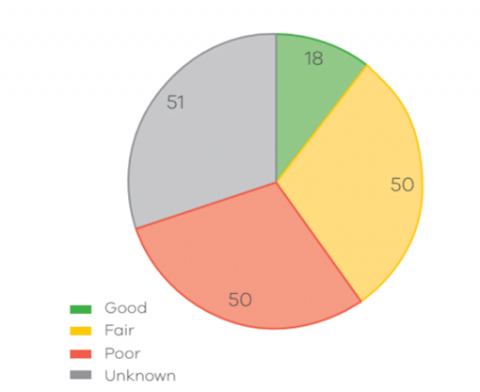Victoria’s comprehensive report card on the health of Victoria’s natural environment, the State of Environment (SoE) 2018 Report has been released. The report which tells a story of good progress in some areas and slow progress in others, presents 20 recommendations from Commissioner for Environmental Sustainability Dr Gillian Sparkes including improved air, pollen, water and waste monitoring, localised climate projections (particularly in agricultural regions) and the appointment of a Chief Biodiversity Scientist for Victoria.
“SoE 2018 is the most comprehensive scientific baseline SoE report produced in Victoria in recent history” says Dr Sparkes. The 2018 report analyses 170 indicators across 13 themes, providing the most comprehensive scientific assessment in a Victorian State of the Environment report produced since the role of the Commissioner was established.
SoE 2018 environmental indicators trend summary for 169* of 170 indicators. The trend expresses whether the status of the indicator is deteriorating, improving or remaining stable. The indicators that are improving include more than half of the energy indicators. Conversely, indicators assessed as deteriorating include more than half of the biodiversity indicators.

*Note: An indicator in the Land chapter is not applicable for trend assessment and is not included in this summary.
For the first time, all 170 SoE indicators have been aligned to the United Nations Sustainable Development Goals (SDGs), setting up the SDGs as the next Victorian State of Environment reporting framework. The indicator assessments, combined with an analysis of global mega trends affecting Victoria’s environment over the next decade, provided the evidence base and strategic context for developing the report’s 20 recommendations. These recommendations establish a blueprint for immediate action and future focus, to support the Victorian government to keep improving its environmental monitoring and management systems, and capabilities over the next decade and beyond.
The report summarises the health of Victoria’s environment at a time of unprecedented population growth. It contains a comprehensive scientific baseline of Victoria’ environment, an analysis of the quality and availability of scientific data on Victoria’s environment and the pressures and challenges ahead. “Every Victorian, every city, town and regional community, and every business has a vital interest in protecting the environment they live and work in,” says Dr Sparkes. “Victoria is their backyard.”
The indicators tell essentially three stories – one on the health of Victoria’s environment, secondly the adequacy of our science and monitoring programs and thirdly the areas for future focus by the Victorian government. “A business as usual approach to environmental management will not enable us to keep pace with the adaptive management required to cope with climate risks and population growth,” says Dr Sparkes. “We need to be able to understand and act faster than ever before. Government must build capability, harness citizen science and move beyond traditional methods of environmental monitoring and reporting.”
“Victoria is forecast to grow at an average rate of 1.5% per annum to almost 8 million citizens by 2031 and 10 million by 2051,” says Dr Sparkes. “This growth puts pressure on our natural environment. I am confident that the findings and recommendations in the SoE 2018 report will be used to benefit Victoria’s natural capital for many years to come.”
